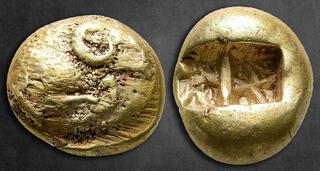Lot description:
Ionia. Uncertain mint. circa 600-550 BC.
Trite - Third Stater EL
13 mm, 4,69 g
Forepart of a ram to right, on a raised oval shield-like surface / Two incuse squares with irregular surfaces
Good Very Fine
Hilbert Abb. 137: III.8; Traité II/1 –; BMC Ionia –; SNG von Aulock –; L. Weidauer, Probleme der frühen Elektronprägung, Typos 1, Fribourg (Switzerland), 1975, - cf. 136–137 (horse, head turned); M. Mignucci, "Elettro arcaico, incroci di conio inediti", GNS 42/166, 1992, 3. MFA Boston 1759 (same dies). Cf. Numismatica Ars Classica, Auction 74, lot 290. (2013). M.-M. Bendenoun, Coins of the Ancient World, A Portrait of the JDL Collection, Tradart, Genève, 2009, 25.
Of the highest rarity, apparently only four specimens known.
As with most uninscribed, early electrum coins of Asia Minor, it is not possible to identify the mint of this trite with any degree of confidence. However, it was struck to the Milesian standard, and in every other respect would seem to be Ionian. In her commentary on an example from the same dies in the Boston Museum of Fine Arts (no. 1759), Agnes Baldwin Brett proposed that it was struck in Clazomenai. She reasoned, in part, that the ram, a symbol of Apollo, was commonly used as a coin design of that city during the 4th Century B.C. In his 1992 survey of this issue of trites, Mignucci observes that die links and a commonality in style, fabric and production quality indicates this type belongs to a small group of electrum staters and trites produced at a single mint in a short period. The high standard of engraving, which displays the full vigour of Archaic Greek art, makes it probable that this coinage is from one of the more important mints in Ionia. The other coins in the group appear to be the staters Weidauer 52-54, 131-132 and 135, and the trites Weidauer 136-137. Quote: Numismatica Ars Classica, Auction 74, lot 290
Starting price: 2500 EUR |  |